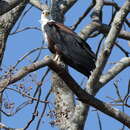Biology
provided by Arkive
The African fish-eagle is a proficient hunter, with live fish accounting for the bulk of its diet (2) (8). It typically hunts from a high perch on a waterside tree, where it can watch for fish moving close to the water's surface. Once prey is sighted, the fish-eagle launches from its perch, swoops low over the water, and at the critical moment throws both feet forward to seize hold of its target with powerful talons. Small fish are carried through the air into a tree but larger catches are dragged through the water to the shoreline. Despite only one in every seven or eight fishing attempts being successful, the African fish-eagle rarely spends more than ten minutes per day actively hunting (2). Aside from fish, this efficient raptor will also take the young of water birds such as the lesser flamingo, and very occasionally will go for monkeys, crocodile hatchlings, frogs and insects. Except for the odd dead fish, fully mature African fish-eagles rarely feed on carrion unless food is particularly scarce (2) (8).
Adult African fish-eagles are normally seen in pairs, but on large productive lakes, nests and roosts may be only a few hundred metres apart, and many birds can be found together in one area (2) (8). The stick nests are usually built in a tree close by water and are used year after year, growing in size over time with the addition of reeds, papyrus heads, bulrushes and sometimes weaver nests (2) (4) (8). Calling and duetting, whilst perched or soaring, is an integral part of the breeding display, and is combined with dramatic aerial dives and falls, with pairs interlocking talons in mid air. The female normally lays one to three eggs in the nest, which are incubated for around 44 days before hatching. Until the chicks fledge after around 65 to 75 days, it is necessary for the adults to spend considerably more time hunting for food, compared with other times of the year. Although in captivity African fish-eagles can live for more than 40 years, in the wild those that are fortunate to survive the first year have an estimated life expectancy of 12 to 24 years (2) (8).
Conservation
provided by Arkive
There are no known conservation measures in place for the African fish-eagle.
Description
provided by Arkive
With its distinctive plumage and evocative cry, the African fish-eagle is probably the most familiar bird of prey in Africa (2) (4). Perched majestically on a high branch, the contrast between the white upper-body and tail, the chestnut belly, and the black wings, is unmistakeable (2) (5) (6). Much less striking is the almost scruffy appearance of the immature African fish-eagle, with its generally dark-brown plumage and white mottling (2) (6). Although after the first year the plumage begins to resemble that of the adult, it will take at least four to five years and numerous moults to reach full maturity (2) (7). The clear, ringing call weee-ah hyo-hyo-hyo, made with the head thrown back, has to be the most characteristic and evocative sound of African watersides (2).
Habitat
provided by Arkive
This fish-eagle is associated with a diverse range of aquatic habitats from rivers, lakes and dams to swamps and mangrove lagoons (2) (4) (6).
Range
provided by Arkive
The African fish-eagle occurs throughout much of sub-Saharan Africa (2).
Status
provided by Arkive
Classified as Least Concern (LC) on the IUCN Red List (1) and listed on Appendix II of CITES (3).
Threats
provided by Arkive
While wetland degradation and water pollution has affected African fish-eagles in some areas, this species has benefited considerably from the construction of large dams, particularly in Southern Africa (2) (4). Given that its population appears to be stable and widely distributed, the African fish-eagle is not considered to be under any significant threat (9).

